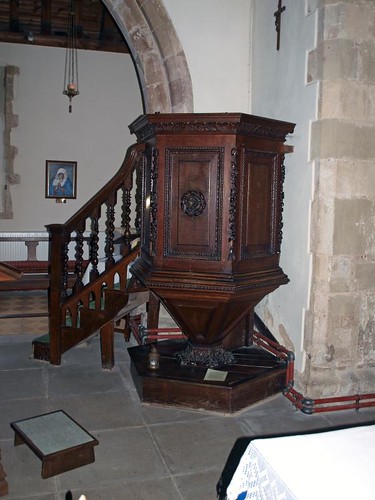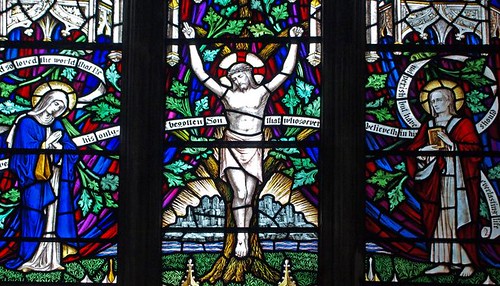All Saints, on the face of it, looked to be the highlight of the day - the exterior, apart from an ill conceived and poorly designed meeting room, promised so much but inside was a disappointment despite a good pulpit, some OK Nicholson glass and the repositioned Moses and Aaron reredos portraits (a first for me which led to some research and new understanding) it was all a bit underwhelming.
ALL SAINTS. Ambitious embattled W tower with angle buttresses with three set-offs, bands of flint and stone, and also some flint and stone chequerwork. The windows indicate a C14 date. Restored in 1892 with American money, in memory of Lawrence Washington, rector from 1632 to 1643. Brick S porch with a four-centred doorhead and two-light W and E windows. Early C14 chancel, see the intersected and cusped three-light E window and the similar two-light N and S windows, also the Sedilia and Piscina, where however ogee arches occur at the tops of the cusping. Nave arcades with thick short octagonal piers and double-chamfered arches. Those of the S arcade die against the vertical continuation of the piers. - PULPIT. Elegant piece of c. 1700 ; staircase with twisted balusters, nicely framed panels and garlands hanging down the angles. - COMMUNION RAIL. Early C18? The balusters not twisted, but no longer of C17 forms. - REREDOS. 1758. Now dismantled. The large paintings of Moses and Aaron by one I. Fairchild. - CHANDELIER. Brass; given in 1758. - STAINED GLASS. Early C14 tabernacles in the heads of the chancel N and S windows. Later C14 tabernacles in a S aisle window. - PLATE. Fine set of c. 1760 with gadroon ornament.



PURLEIGH. It is a hilltop village to which Americans come, for here preached Lawrence Washington, the great-great-grand-father of the Father of the United States for ten years, he was thrust out of Purleigh in 1643, and his son John sailed for Virginia in 1657. The 14th century church he knew is a handsome place and has been carefully restored by American friends in memory of the Washingtons. We found a portrait of George Washington and his mother hanging on the walls.
The tower is made beautiful by bands of knapped fiints, and little flint crosses ornament the buttresses. Both tower and chancel have bands of 14th century bricks with glazed surfaces, rare examples of early brickwork. The bricks in the porch are Tudor, and the porch shelters a door with iron strap-hinges which has been opening and shutting for 600 years. All this time a leopard has been looking down from one of the windows, shining in the sunlight of 600 summers. A modern window has the portrait of John Wycliffe, and two great oil paintings of Moses and Aaron hang on the walls. The pulpit was made in Queen Anne’s reign, and one of the preachers, Provost Hawkins, preached from it for 55 years last century.
Simon K -
From Mundon, I was planning to cycle back to Hatfield Peveril station
rather than Chelmsford, and I pottered westwards to Purleigh.
James Bettley in the revised Pevsner observes cheerily that
the church is well-sited on the top of what is, in these parts, a
considerable hill. It certainly is. I could see it like a castle from a mile or so off,
and entering the pretty village the road began to climb steeply. I
slogged on in low gear into what turned out to be a very pretty
village, very atmospheric, and the first place I'd visited to day that
I could imagine wanting to live.
In the middle of the village is the church. Open. A big church - the
first big church since Great Baddow, the first big church to be open.
Entirely East Anglian in style, but built in the Kent fashion from
layered flint and greenstone.
The interior full of light, only a few windows all of good quality by
AK Nicholson. An unfair comparison after Mundon, of course, but
strangely lacking in atmosphere. The hill beyond was even steeper, and
I was glad I had approached from the east and not the west. A couple
of miles further on brought me to the Chelmsford to Maldon road, and
as I crossed it the landscape changed completely - now it was the
Essex I remembered from bike rides last year, rich and green,
hedgerows, pretty villages and the like.
